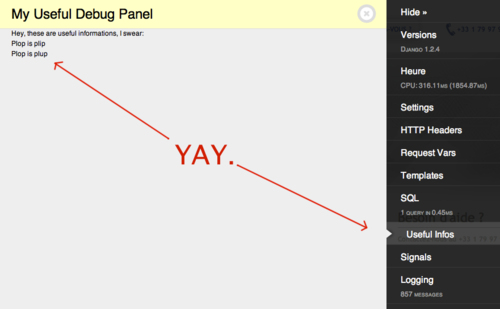Sometimes you work on stuff you don’t really control, eg. when interacting with some mysterious SOAP server across the Internets, and you’d appreciate a little help from the Django ecosystem to ease debugging.
That’s — you guessed it — my case currently, and I really appreciated being able to create my own custom panel for adding specific debugging capabilities to the awesome Django Debug Toolbar.
Here’s how I did, learning mainly from the code of the panels shipping with the DJT. I’m supposing you have installed and configured the DJT in your project already.
First of all, create a panels.py module within one of your app (or wherever you want as it’s in your python path) and create a DebugPanel derivated class, like this:
from debug_toolbar.panels import DebugPanel
from django.template.loader import render_to_string
from django.utils.translation import ugettext_lazy as _
class MyUsefulDebugPanel(DebugPanel):
name = 'MyUseful'
has_content = True
def nav_title(self):
return _('Useful Infos')
def title(self):
return _('My Useful Debug Panel')
def url(self):
return ''
def content(self):
context = self.context.copy()
context.update({
'infos': [
{'plop': 'plip'},
{'plop': 'plup'},
],
})
return render_to_string('panels/my_useful_panel.html', context)
The debug panel class methods and code should be self-explanatory enough. Just note you have to create a template, here panels/my_useful_panel.html to be stored in your project templates directory, with this kind of contents:
<p>Hey, these are useful informations, I swear:</p>
<ul>
{% for info in infos %}
<li>Plop is {{ info.plop}}</li>
{% endfor %}
</ul>
Now you have to register the new panel by adding its path to the DEBUG_TOOLBAR_PANELS tuple, in your settings.py (create it if it’s not there):
DEBUG_TOOLBAR_PANELS = (
'debug_toolbar.panels.version.VersionDebugPanel',
'debug_toolbar.panels.timer.TimerDebugPanel',
'debug_toolbar.panels.settings_vars.SettingsVarsDebugPanel',
'debug_toolbar.panels.headers.HeaderDebugPanel',
'debug_toolbar.panels.request_vars.RequestVarsDebugPanel',
'debug_toolbar.panels.template.TemplateDebugPanel',
'debug_toolbar.panels.sql.SQLDebugPanel',
'debug_toolbar.panels.signals.SignalDebugPanel',
'debug_toolbar.panels.logger.LoggingPanel',
'my_app_name.panels.MyUsefulDebugPanel',
)
Of course it’s up to you to put really useful informations there, but here’s the result, tadaa:

Thanks for reading, happy ponying.
 This post has been published more than 13 years ago, it may
be obsolete by now.
This post has been published more than 13 years ago, it may
be obsolete by now.